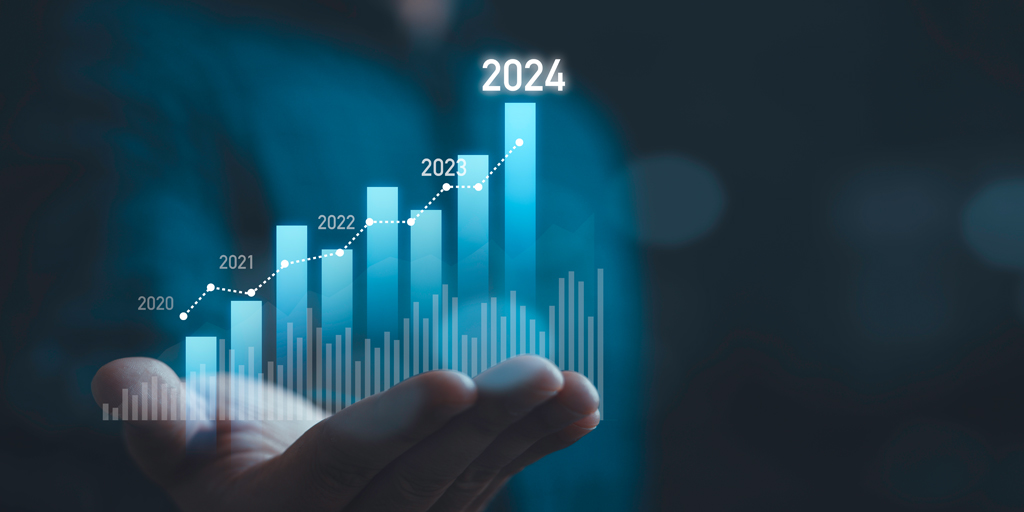Blog & Insights
What’s Ahead for Collections and Recovery Organizations in 2024?

Collections and recovery organizations will keep a close eye on the U.S. economy in 2024. But this doesn’t mean that these organizations should be in wait-and-see mode. Instead, they must look at all potential outcomes and prepare to take advantage of whatever develops.
U.S. economic uncertainty
Stop me if you’ve heard this before – the U.S. economy will struggle in 2024. That’s what was predicted for 2023, and those who bet on pessimism are doubling down for 2024. General growth forecasts for the U.S. economy remain at around 1.2% and recession odds are seen at 50% by many.
While the U.S. economic outlook remains deeply uncertain, the macroeconomic situation in 2024 will remain difficult. Given this difficult outlook, the Federal Reserve Bank of New York projects a 52% chance that the U.S. will fall into a recession during the next 12 months.
However, the U.S. economy outperformed many of those negative forecasts in 2023. The U.S. not only avoided a recession but has grown at a steady clip. Unemployment has been low and inflation is falling.
This is leading some to predict similar results for 2024. The indicators for this optimism include:
- Core inflation has fallen sharply from its pandemic peak and should drop again.
- The GDP is expected to grow 1.8% in 2024, beating low consensus expectations.
- The Fed should deliver its first interest rate cut in Q4 of 2024.
- This leads to a 15% probability of recession over the next 12 months.
Consumer debt struggles
According to the Federal Reserve Bank of New York, Americans now owe $1.08 trillion on their credit cards. And the 30-day delinquency rate (or the percentage of total outstanding credit card balances currently at least 30 days overdue) rose from 2.77% in the second quarter of 2023 to 2.98% in the third quarter of 2023.
Credit card balances have increased 15% from one year ago, while the average balance per consumer hit $6,088 – the highest in 10 years. And more cardholders are carrying debt from month to month, with fewer consumers being able to pay off their balances in full. The share of credit card holders that carry a balance has increased to 49% — up from 39% in 2021.

In addition, many auto loans are underwater. Longer-term auto loans, higher interest rates, and an easing of supply chain issues have helped to create the situation. Currently, the average negative equity of $6,054 is the highest since April 2020 and well above pre-pandemic levels.
Strategies for success
The potential for an economic depression will affect how consumers spend and pay their bills. Consumers are still struggling with credit card debt and are less able to pay bills. Therefore, it is incumbent upon collections and recovery organizations to develop collection strategies that fit customer needs during times of economic hardship.
These strategies must address the entire customer lifecycle to improve the chances of successfully collecting. However, if the economy continues to improve, these strategies will still be valuable, as they will provide customers with the type of personalized experience expected by today’s digital citizen.
Ultimately, this will require an investment in new technology and solutions.
Technology investment
Data analytics and digital communication are key areas of investment for collections and recovery agencies in 2024.
- Data analytics: The digital world provides organizations with a host of data about customers and their preferences. This data is vital in creating collection strategies, as well as in streamlining business operations and employee training.
- Digital communication: Organizations can increase collection rates by contacting customers through their channel of choice whether by email, text, phone, or letter. And employees can be more efficient by creating, executing, and tracking communications through the same system.
Investing in these areas will provide you with critical data to help you better understand your customers. This knowledge can then be used to develop repayment plan offers that make the most sense given each customer’s unique financial circumstance.
It can also be used to help collections and recovery organizations improve each step along the customer journey, including:
- On-boarding: Optimize the first 90 days of a new customer relationship through personalized engagement.
- Servicing: Provide personalized service developed from detailed records of all customer interactions.
- Collections: Tailored treatments and offers across customer segments and channels to drive engagement at the segment level.
- Recovery: Assign and retrieve accounts placed with agencies with proper oversight, as well as process charge-off and post-charge-off transactions for accounting purposes.
Conclusion
The financial hardships facing today’s consumers, as well as the continued uncertainty around the U.S. economy, will pose some challenges for the collections and recovery organizations. To best manage these challenges, organizations must invest in technology that will not only help make employees more efficient and productive, but also better connect with customers, improving the overall experience and seeing a greater return on those technology investments.


